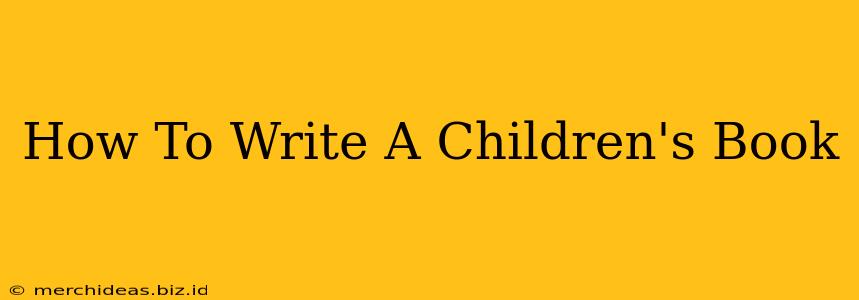So, you've got a fantastic idea brewing – a children's book! That's wonderful! But turning that idea into a polished manuscript that captures young hearts (and attracts publishers) takes more than just a good story. This guide will walk you through the process, step-by-step.
1. Finding Your Story: Brainstorming and Idea Generation
Before you even touch a keyboard, dedicate time to brainstorming. What kind of story are you drawn to? Consider these questions:
- Age Group: Picture books (for preschoolers), early readers (beginning readers), chapter books (for older children)? The age group dictates length, complexity, and vocabulary.
- Genre: Adventure, fantasy, realistic fiction, humor, educational? What resonates with you? Passion is infectious!
- Theme: What message do you want to convey? Children's books often explore themes of friendship, courage, overcoming challenges, or celebrating diversity.
- Characters: Who are your main characters? Give them distinct personalities, flaws, and motivations. Make them relatable!
Pro-Tip: Don't be afraid to draw inspiration from your own childhood memories, observations of children, or even current events.
Developing Your Idea: From Seed to Story
Once you have a general idea, start fleshing it out. Create an outline, even a simple one, to structure your narrative. This outline doesn't need to be rigid, but it will provide a roadmap for your writing journey. Consider:
- Plot: What happens in the story? What is the central conflict? How is it resolved?
- Setting: Where and when does your story take place? Describe the setting vividly.
- Characters' Arcs: How do your characters change and grow throughout the story?
2. Writing Your First Draft: Getting the Words Down
With your idea solidified, it's time to write! Don't worry about perfection at this stage. Focus on getting the story down on paper (or screen). Remember:
- Keep it Simple: Use age-appropriate language and sentence structure. Avoid overly complicated words or phrases.
- Show, Don't Tell: Use descriptive language to paint pictures in the reader's mind.
- Read Aloud: As you write, read your work aloud. This helps identify awkward phrasing or pacing issues.
Pro-Tip: Write regularly, even if it's just for 15 minutes a day. Consistency is key!
3. Revision and Editing: Polishing Your Manuscript
Your first draft is just the beginning! Revision and editing are crucial for creating a polished, engaging manuscript. Consider:
- Content: Does the story flow logically? Are there any plot holes or inconsistencies?
- Structure: Is the pacing right? Are there any unnecessary scenes or descriptions?
- Word Choice: Have you used the most precise and effective language?
- Grammar and Mechanics: Proofread carefully for errors in grammar, spelling, and punctuation.
Pro-Tip: Get feedback from beta readers – friends, family, teachers, or members of a writing group. Their fresh perspectives can be invaluable.
4. Illustrating Your Book (or Finding an Illustrator)
If you're writing a picture book, illustrations are just as important as the text. You have two options:
- Illustrate Yourself: If you have artistic skills, consider illustrating your own book.
- Hire an Illustrator: Many talented illustrators are available for hire. Research different styles to find one that complements your story.
5. Getting Your Book Published: The Publishing Process
Once your manuscript and illustrations are complete, you're ready to explore publishing options:
- Traditional Publishing: Submit your manuscript to publishing houses. This route requires patience and perseverance.
- Self-Publishing: You retain more control over the publishing process, but it requires investment and marketing expertise.
Conclusion: The Journey of a Children's Book Author
Writing a children's book is a rewarding but challenging endeavor. Be patient, persistent, and embrace the process. With creativity, hard work, and a touch of magic, your story can bring joy to young readers for years to come. Remember to always revise, edit and seek feedback before submitting to a publisher or self-publishing. Good luck!
